Thermal Comfort and Adaptive Occupant Behaviour in Open Plan Offices in India and Lithuania
Abstract
1. Introduction
2. Materials and Methods
2.1. Selected Offices
2.1.1. Offices in India
| IN1 | IN2 | IN3 | IN4 | IN5 | LT1 | LT2 | |
|---|---|---|---|---|---|---|---|
| Monitoring period | 23 May to 29 May, 2022 | 31 May to 6 June, 2022 | 23 June to 29 June, 2022 | 4 July to 10 July, 2022 | 21 July to 28 July, 2022 | 3 April to 12 April, 2023 | 24 April to 30 April, 2023 |
| Season | Summer | Summer | Monsoon | Monsoon | Monsoon | Spring (heating) | Spring (heating) |
| Floor number of the building/Total number of floors | 4/4 | 8/12 | 9/15 | 5/5 | 2/4 | 3/4 | 3/5 |
| Floor area (m2) | 462 | 107 | 557 | 1115 | 110 | 1096 | 600 |
| No. of workstations | 102 | 25 | 100 | 250 | 45 | 235 | 46 |
| No. of employees | 85 | 23 | 98 | 165 | 25 | 128 | 50 |
| Occupant density (m2/person) | 5.4 | 4.7 | 5.7 | 6.8 | 4.4 | 8.6 | 12 |
| HVAC control | On request | On request | On request | On request | Direct 1 | Direct 1 | Direct 1 |
| Flexibility in clothing | No | Yes | No | No | No | Yes | Yes |
| Operable windows (open plan offices) | No | No | No | No | Yes | Yes | No |
2.1.2. Offices in Lithuania
2.2. Data Collection
2.2.1. General Overview of the Questionnaire
2.2.2. Objective Measurements
3. Results and Discussion
3.1. “Right-Now” Survey Questions and Measured Data
3.1.1. Thermal Sensation of the Occupants
- PMV1 (air speed = 0.1 m/s, increased mean radiant temperature by 1 °C):
- PMV2 (air speed = 0.2 m/s, decreased mean radiant temperature by −1 °C):
3.1.2. Perception of Thermal Comfort
3.1.3. Thermal Preference of Occupants
3.1.4. Adaptive Thermal Comfort Model
3.2. Adaptive Behaviour in the Offices
3.3. Relationship Between Thermal Comfort and Adaptive Behaviours
4. Limitations and Future Work
5. Conclusions
Supplementary Materials
Author Contributions
Funding
Data Availability Statement
Conflicts of Interest
References
- Demanuele, C.; Tweddell, T.; Davies, M. Bridging the gap between predicted and actual energy performance in schools. In Proceedings of the World Renewable Energy Congress XI, Abu Dhabi, United Arab Emirates, 25–30 September 2010; pp. 1–6. [Google Scholar]
- Menezes, A.; Cripps, A.; Bouchlaghem, D.; Buswell, R. Predicted vs. actual energy performance of non-domestic buildings. In Proceedings of the Third International Conference on Applied Energy, Perugia, Italy, 16–18 May 2011; Volume 97, pp. 355–364. Available online: https://dspace.lboro.ac.uk/dspace-jspui/handle/2134/9429 (accessed on 15 January 2024).
- Mahdavi, A.; Jazizadeh, A.; Wagner, A.; O’Brien, W. Ten questions concerning occupant-centric control and operations. Build. Environ. 2023, 238, 110518. [Google Scholar] [CrossRef]
- O’Brien, W.; Zhang, T.; Alston, S.C.J.; Sadeghi, A.A.; Mahdavi, A. Introducing IEA EBC Annex 79: Key challenges and opportunities in the field of occupant-centric building design and operation. Build. Environ. 2020, 178, 106738. [Google Scholar] [CrossRef]
- De Wilde, P. The gap between predicted and measured energy performance of buildings: A framework for investigation. Autom. Constr. 2014, 41, 40–49. [Google Scholar] [CrossRef]
- Yan, H.; Shi, F.; Sun, Z.; Yuan, G.; Wang, M.; Dong, M. Thermal adaptation of different set point temperature modes and energy saving potential in split air-conditioned office buildings during summer. Build. Environ. 2022, 225, 109565. [Google Scholar] [CrossRef]
- Tanabe, S.I.; Haneda, M.; Nishihara, N. Workplace productivity and individual thermal satisfaction. Build. Environ. 2015, 91, 42–50. [Google Scholar] [CrossRef]
- Government of Japan. Press Release [Ministry of Environment]. 2005. Available online: https://www.env.go.jp/en/press/2005/1028a.html (accessed on 26 January 2024).
- Takagi, K. The Japanese Cool Biz Campaign: Increasing Comfort in the Workplace | Article | Environmental and Energy Study Institute. 2015. Available online: https://www.eesi.org/articles/view/the-japanese-cool-biz-campaign-increasing-comfort-in-the-workplace (accessed on 24 November 2023).
- Liu, Y.; Xu, H.; Zheng, P.; Lin, B.; Wu, H.; Huang, Y.; Li, Z. Thermal preference prediction based on occupants’ adaptive behavior in indoor environments—A study of an air-conditioned multi-occupancy office in China. Build. Environ. 2021, 206, 108355. [Google Scholar] [CrossRef]
- Alamirah, H.; Schweiker, M.; Azar, E. Immersive virtual environments for occupant comfort and adaptive behavior research—A comprehensive review of tools and applications. Build. Environ. 2022, 207, 108396. [Google Scholar] [CrossRef]
- Rupp, R.F.; Kim, J.; de Dear, R.; Ghisi, E. Associations of occupant demographics, thermal history and obesity variables with their thermal comfort in air-conditioned and mixed-mode ventilation office buildings. Build. Environ. 2018, 135, 1–9. [Google Scholar] [CrossRef]
- Pigliautile, I.; Casaccia, S.; Morresi, N.; Arnesano, M.; Pisello, A.L.; Revel, G.M. Assessing occupants’ personal attributes in relation to human perception of environmental comfort: Measurement procedure and data analysis. Build. Environ. 2020, 177, 106901. [Google Scholar] [CrossRef]
- Indraganti, M. Behavioural adaptation and the use of environmental controls in summer for thermal comfort in apartments in India. Energy Build. 2010, 42, 1019–1025. [Google Scholar] [CrossRef]
- Indraganti, M.; Ooka, R.; Rijal, H.B.; Brager, G.S. Drivers and barriers to occupant adaptation in offices in India. Archit. Sci. Rev. 2015, 58, 77–86. [Google Scholar] [CrossRef]
- Indraganti, M.; Ooka, R.; Rijal, H.B. Thermal comfort in offices in India: Behavioral adaptation and the effect of age and gender. Energy Build. 2015, 103, 284–295. [Google Scholar] [CrossRef]
- Liu, J.; Yao, R.; Wang, J.; Li, B. ‘Occupants’ behavioural adaptation in workplaces with non-central heating and cooling systems. Appl. Therm. Eng. 2012, 35, 40–54. [Google Scholar] [CrossRef]
- Rupp, R.F.; Andersen, R.K.; Toftum, J.; Ghisi, E. Occupant behaviour in mixed-mode office buildings in a subtropical climate: Beyond typical models of adaptive actions. Build. Environ. 2021, 190, 107541. [Google Scholar] [CrossRef]
- Humphreys, M.A. Field Studies of Thermal Comfort Compared and Applied. Build. Serv. Eng. 1974, 44, 5–27. [Google Scholar] [CrossRef]
- Langevin, J.; Gurian, P.L.; Wen, J. Tracking the human-building interaction: A longitudinal field study of occupant behavior in air-conditioned offices. J. Environ. Psychol. 2015, 42, 94–115. [Google Scholar] [CrossRef]
- Zheng, P.; Wang, C.; Liu, Y.; Lin, B.; Wu, H.; Huang, Y.; Zhou, X. Thermal adaptive behavior and thermal comfort for occupants in multi-person offices with air-conditioning systems. Build. Environ. 2022, 207, 108432. [Google Scholar] [CrossRef]
- Boerstra, A.C.; Loomans, M.G.L.C.; Hensen, J.L.M. Personal control over temperature in winter in Dutch office buildings. HVAC R Res. 2013, 19, 1033–1050. [Google Scholar] [CrossRef]
- Paciuk, M.T. The Role of Personal Control of the Environment in Thermal Comfort and Satisfaction at the Workplace; University of Wisconsin: Milwaukee, WI, USA, 1989. [Google Scholar]
- Nicol, F.; Humphreys, M.A. Thermal comfort as part of a self-regulating system. Build. Res. Pract. 1073, 1, 174–179. [Google Scholar] [CrossRef]
- Nicol, F.; Humphreys, M.; Roaf, S. Adaptive Thermal Comfort: Principles and Practice; Routledge: London, UK, 2012. [Google Scholar]
- Indraganti, M.; Boussaa, D. Comfort temperature and occupant adaptive behavior in offices in Qatar during summer. Energy Build. 2017, 150, 23–36. [Google Scholar] [CrossRef]
- Tsang, T.W.; Mui, K.W.; Wong, L.T. Adaption and Tolerance in Built Environment—An Evaluation of Environmental Sensation, Acceptance and Overall Indoor Environmental Quality (IEQ) in a Subtropical Region. Sustainability 2023, 15, 11094. [Google Scholar] [CrossRef]
- Liu, Y.; Li, H.; Zheng, P.; Wu, H.; Wang, Z.; Li, Z.; Lin, B. Non-invasive measurements of thermal discomfort for thermal preference prediction based on occupants’ adaptive behavior recognition. Build. Environ. 2023, 228, 109889. [Google Scholar] [CrossRef]
- Singh, M.K.; Ooka, R.; Rijal, H.B.; Kumar, S.; de Dear, R. Adaptive thermal comfort in the offices of three climates of North-East India. J. Build. Eng. 2023, 75, 106843. [Google Scholar] [CrossRef]
- Pawar, A.S.; Mukherjee, M.; Shankar, R. Thermal comfort design zone delineation for India using GIS. Build. Environ. 2015, 87, 193–206. [Google Scholar] [CrossRef]
- Bureau of Indian Standards. National Building Code of India, 2016, 2. Available online: https://archive.org/details/nationalbuilding01/in.gov.nbc.2016.vol1.digital/ (accessed on 15 December 2024).
- Bureau of Energy Efficiency, Energy Conservation Building Code. Ministry of Power, Government of India. 2017. Available online: https://beeindia.gov.in/sites/default/files/publications/files/ECBC%20book%20final%20one%20%202017_0.pdf (accessed on 11 January 2024).
- Rawal, R.; Manu, S.; Shukla, Y.; Thomas, L.E.; De Dear, R. Clothing insulation as a behavioural adaptation for thermal comfort in Indian office buildings. In Proceedings of the 9th Windsor Conference: Making Comfort Relevant, Windsor, UK, 7–10 April 2016; pp. 403–415. [Google Scholar]
- Vilnius, Vilnius, Lithuania Monthly Weather|AccuWeather. Available online: https://www.accuweather.com/en/lt/vilnius/231459/february-weather/231459?year=2023 (accessed on 13 February 2024).
- Kaunas, Kaunas, Lithuania Monthly Weather|AccuWeather. Available online: https://www.accuweather.com/en/lt/kaunas/228309/december-weather/228309?year=2023 (accessed on 13 February 2024).
- Indraganti, M.; Ooka, R.; Rijal, H.B. Field investigation of comfort temperature in Indian office buildings: A case of Chennai and Hyderabad. Build. Environ. 2013, 65, 195–214. [Google Scholar] [CrossRef]
- Ministry of Health. Lithuanian Hygiene Norm HN 69:2003 ‘Thermal Comfort and Sufficient Thermal Environment for Work Premises. Normative Values of Parameters and Measurement Requirements’; Vilnius, Lithuania. Available online: https://e-seimas.lrs.lt/portal/legalAct/lt/TAD/TAIS.230880 (accessed on 12 March 2024).
- ASHRAE and American National Standards Institute. Thermal Environmental Conditions for Human Occupancy. ASHRAE Stand. 55, 2020. Available online: https://www.ashrae.org/technical-resources/bookstore/standard-55-thermal-environmental-conditions-for-human-occupancy (accessed on 25 December 2024).
- Davis, L.L. Instrument review: Getting the most from a panel of experts. Appl. Nurs. Res. 1992, 5, 194–197. [Google Scholar] [CrossRef]
- Polit, D.F.; Beck, C.T. The content validity index: Are you sure you know what’s being reported? critique and recommendations. Res. Nurs. Health 2006, 29, 489–497. [Google Scholar] [CrossRef] [PubMed]
- Humphreys, M.A.; Nicol, J.F. Understanding the adaptive approach to thermal comfort. ASHRAE Trans. 1998, 104, 991–1004. [Google Scholar]
- de Dear, R.J.; Brager, G.S. Developing an adaptive model of thermal comfort and preference. ASHRAE Trans. 1998, 104, 145–167. [Google Scholar]
- Nicol, F.; Humphreys, M. Adaptive thermal comfort and sustainable thermal standards for buildings. Energy Build. 2002, 34, 563–572. [Google Scholar] [CrossRef]
- Rupp, R.F.; Ghisi, E. Predicting thermal comfort in office buildings in a Brazilian temperate and humid climate. Energy Build. 2017, 144, 152–166. [Google Scholar] [CrossRef]
- Manu, S.; Shukla, Y.; Rawal, R.; Thomas, L.E.; de Dear, R. Field studies of thermal comfort across multiple climate zones for the subcontinent: India Model for Adaptive Comfort (IMAC). Build. Environ. 2016, 98, 55–70. [Google Scholar] [CrossRef]
- Thapa, S.; Pernigotto, G. Adaptive Thermal Comfort in the Different Buildings of Temperate Climates—Comparison Between High-Latitude Europe and Mountainous Himalayas in India. Sustainabiliy 2025, 17, 404. [Google Scholar] [CrossRef]
- Ghanta, N.; Kongoletos, J.; Glicksman, L. Comfort control and improved thermostat location in conference rooms and academic working spaces. Build. Environ. 2021, 205, 108192. [Google Scholar] [CrossRef]
- Xie, K.; Lee, M.; Khalid, R.; Zakka, V.G. The impact of personal environmental control on the performance of thermal systems: Building energy consumption, occupant thermal comfort, and productivity. Energy Build. 2023, 298, 113552. [Google Scholar] [CrossRef]
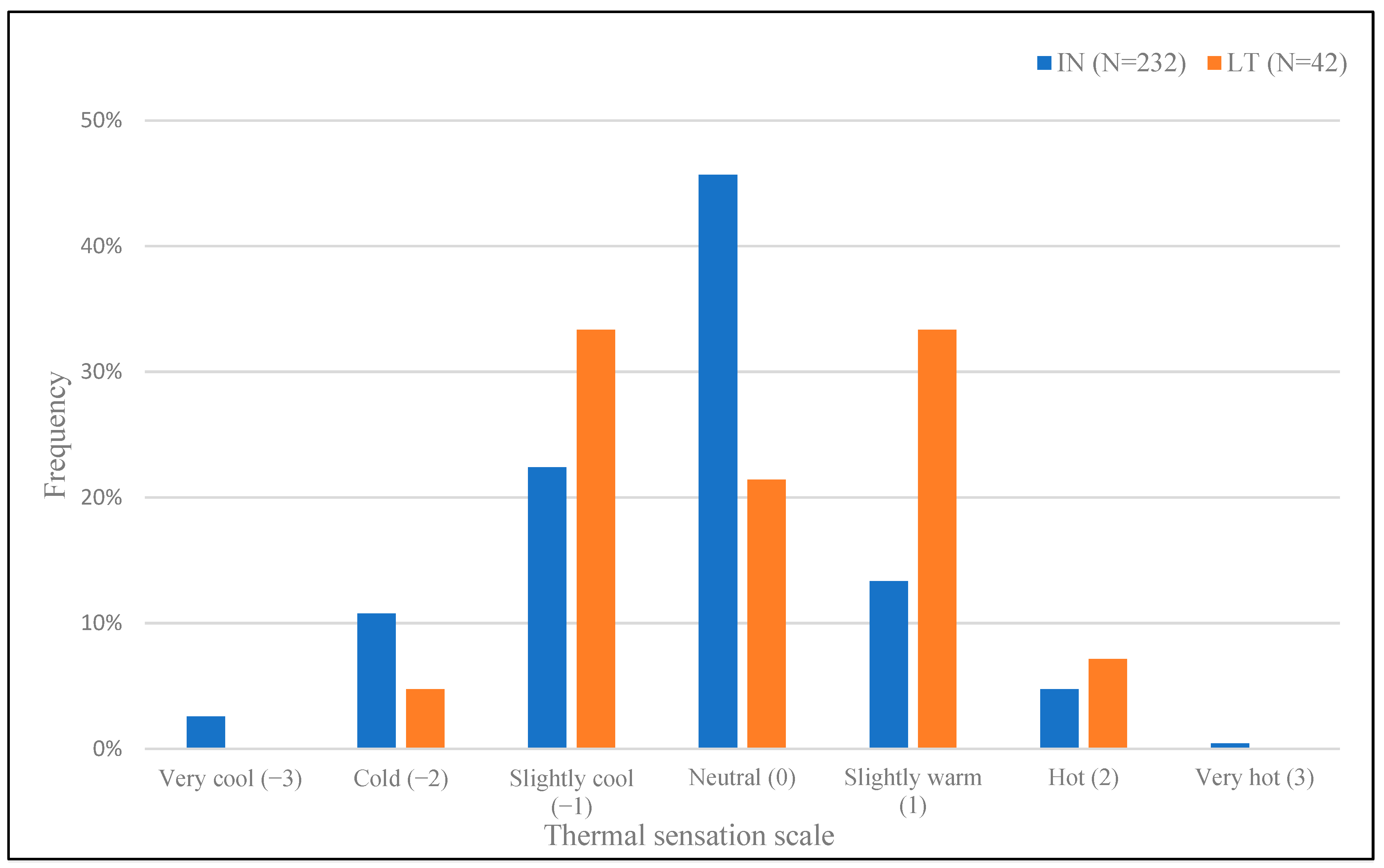
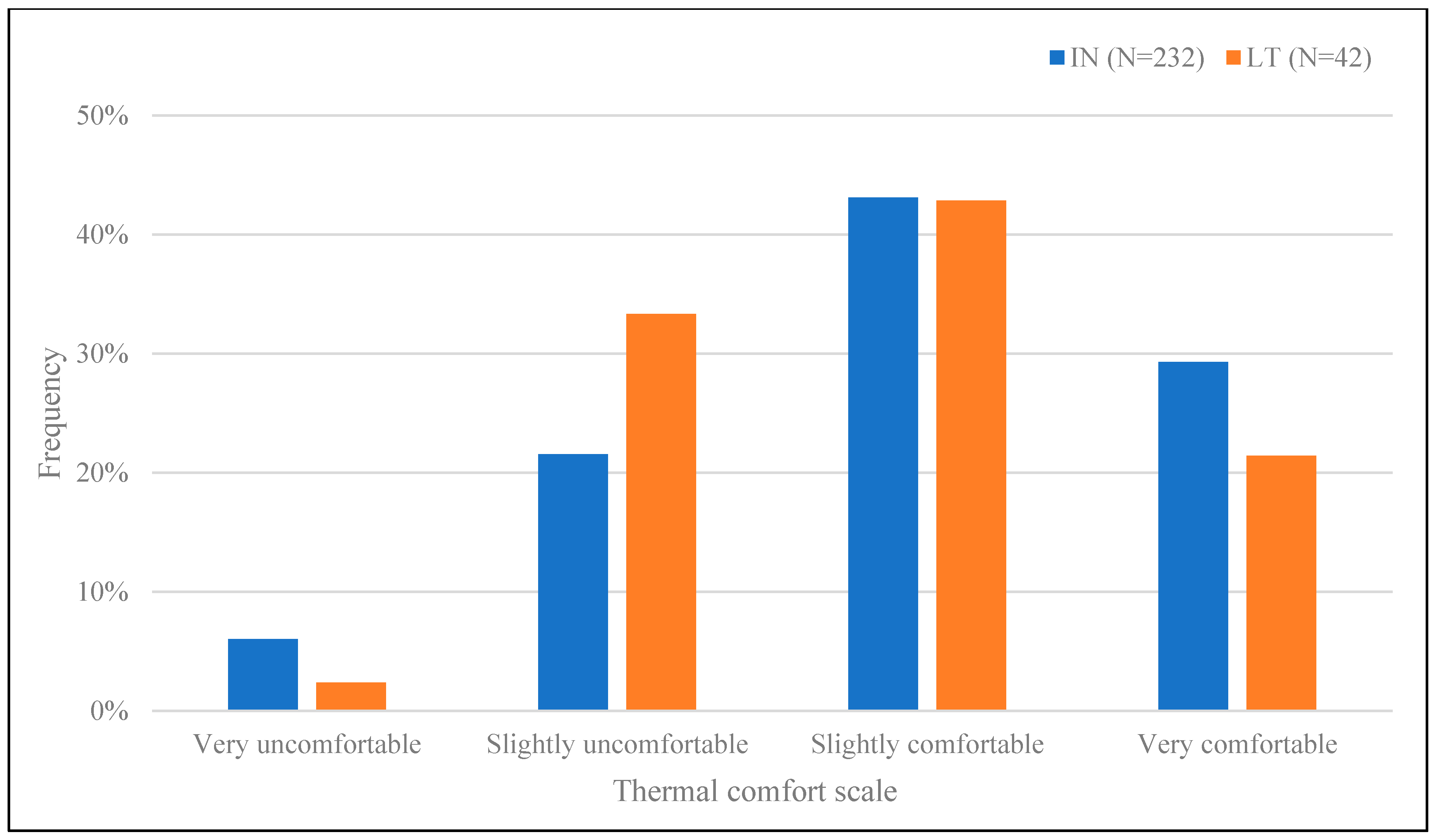

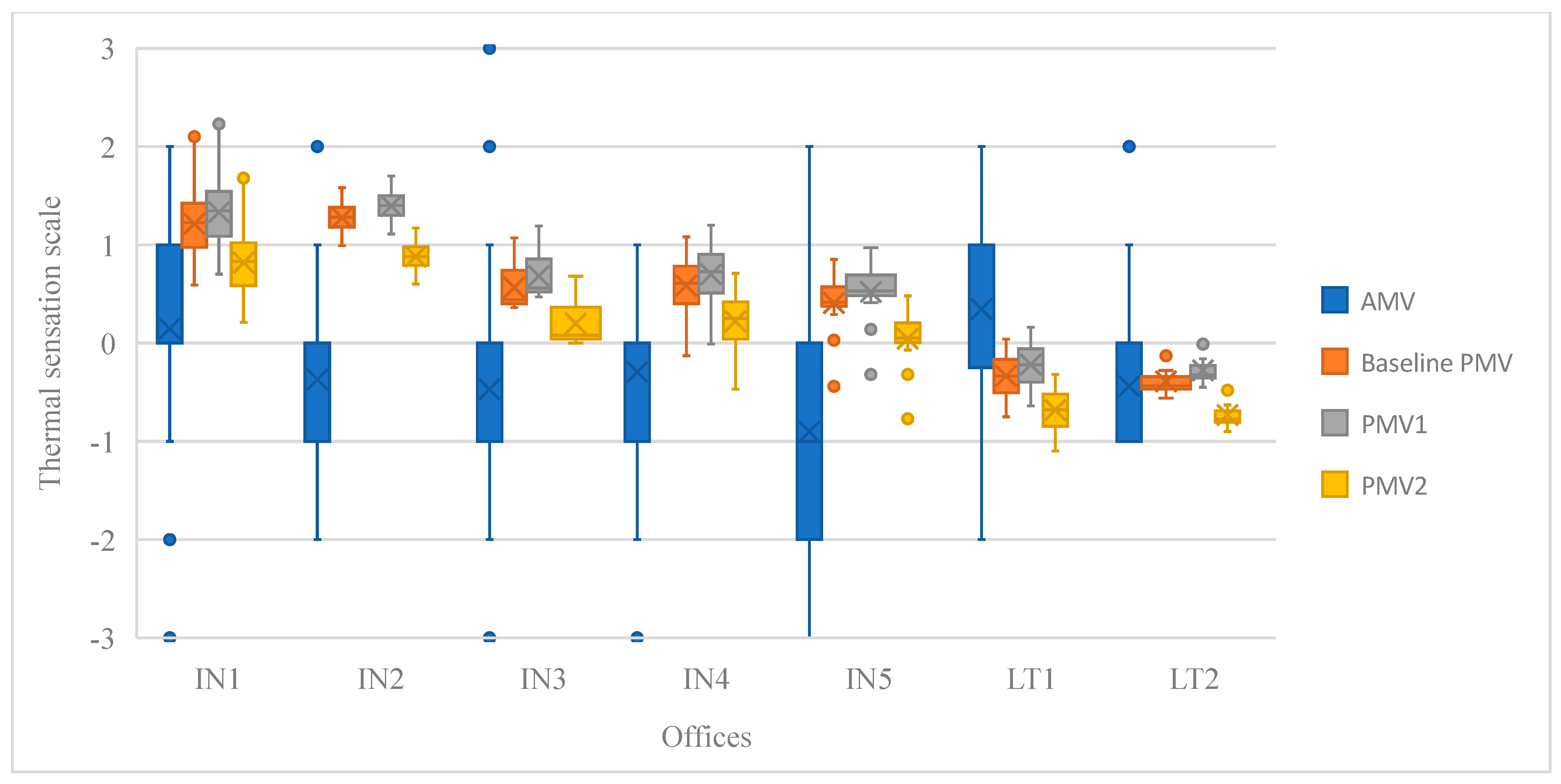

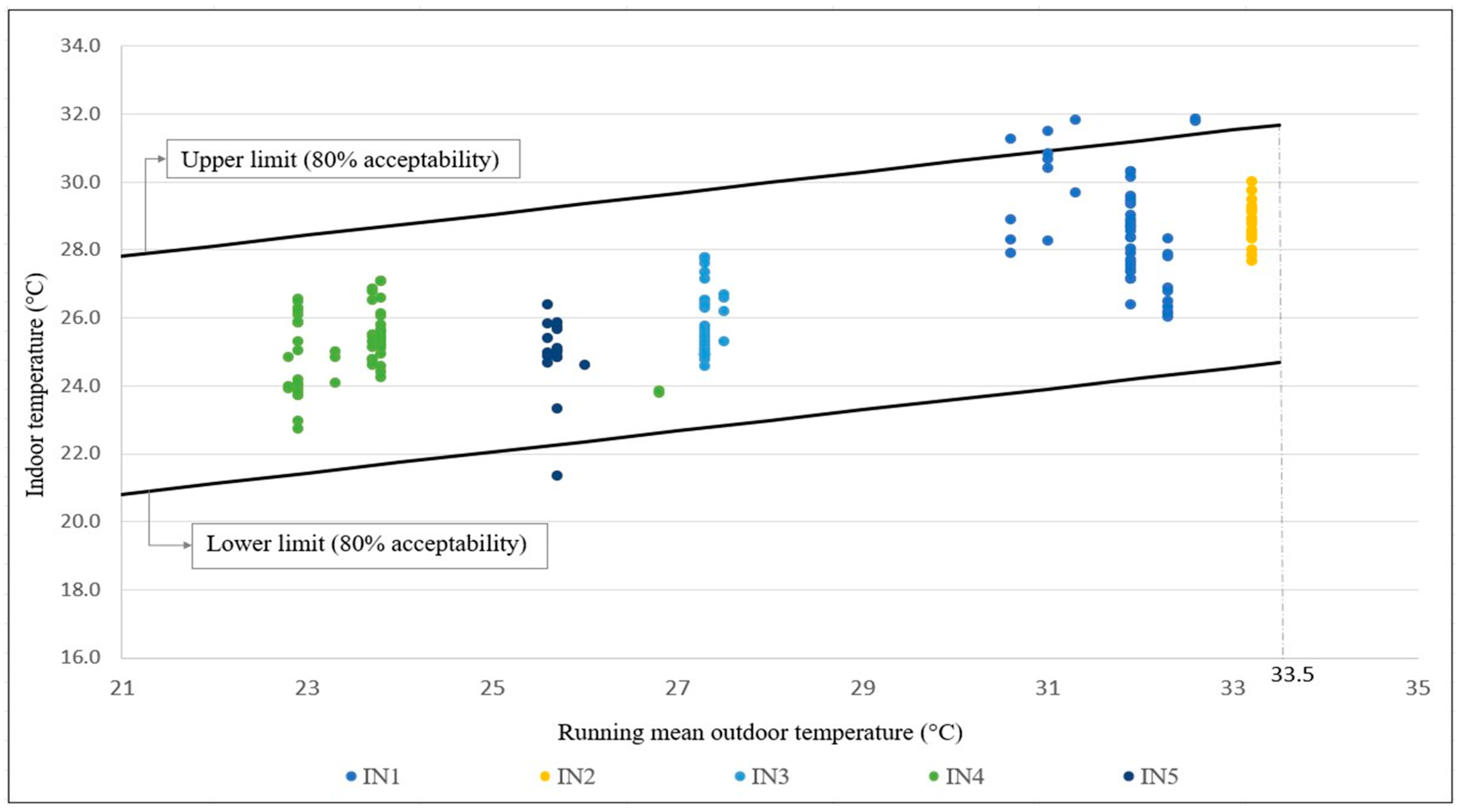
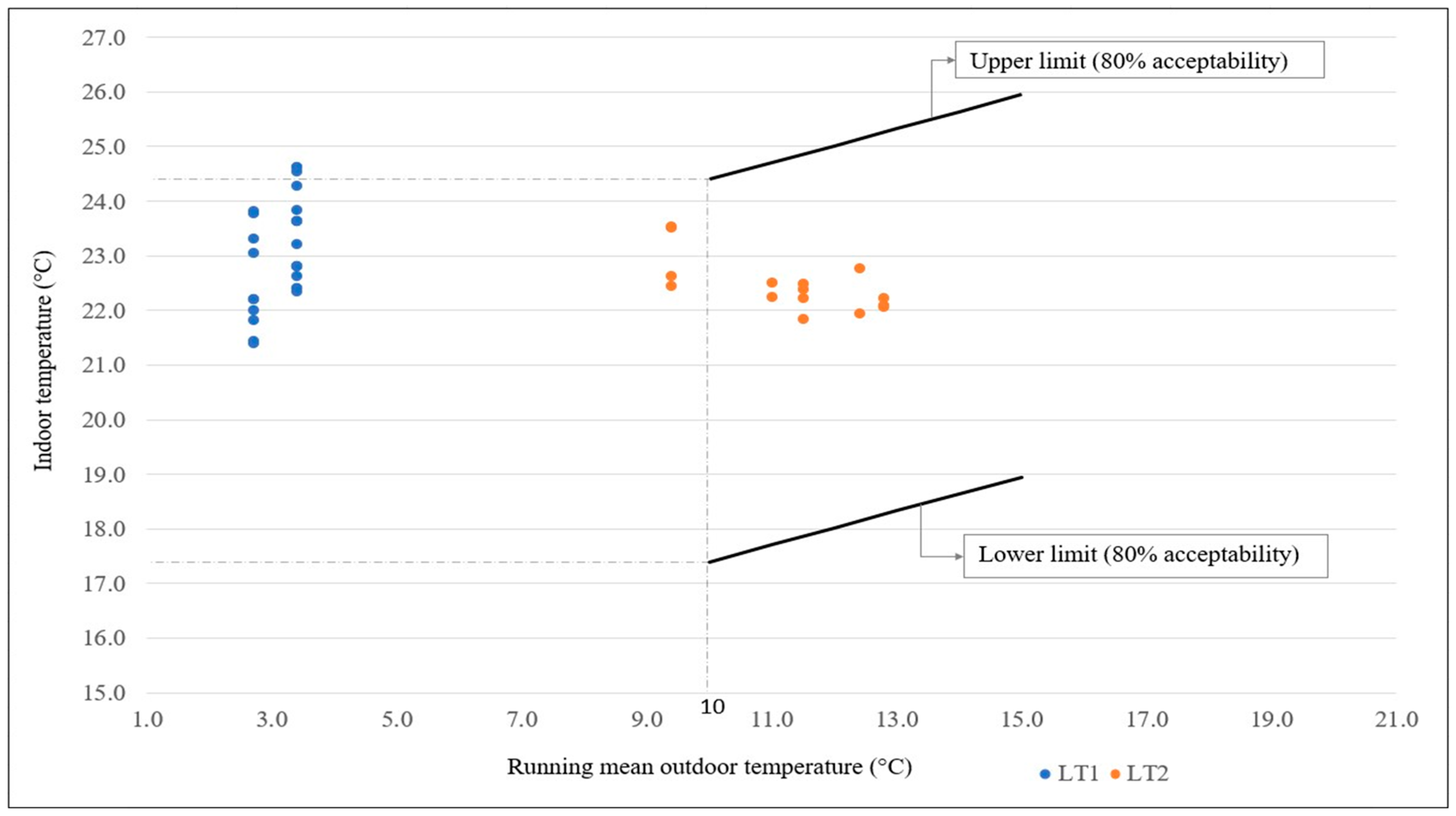

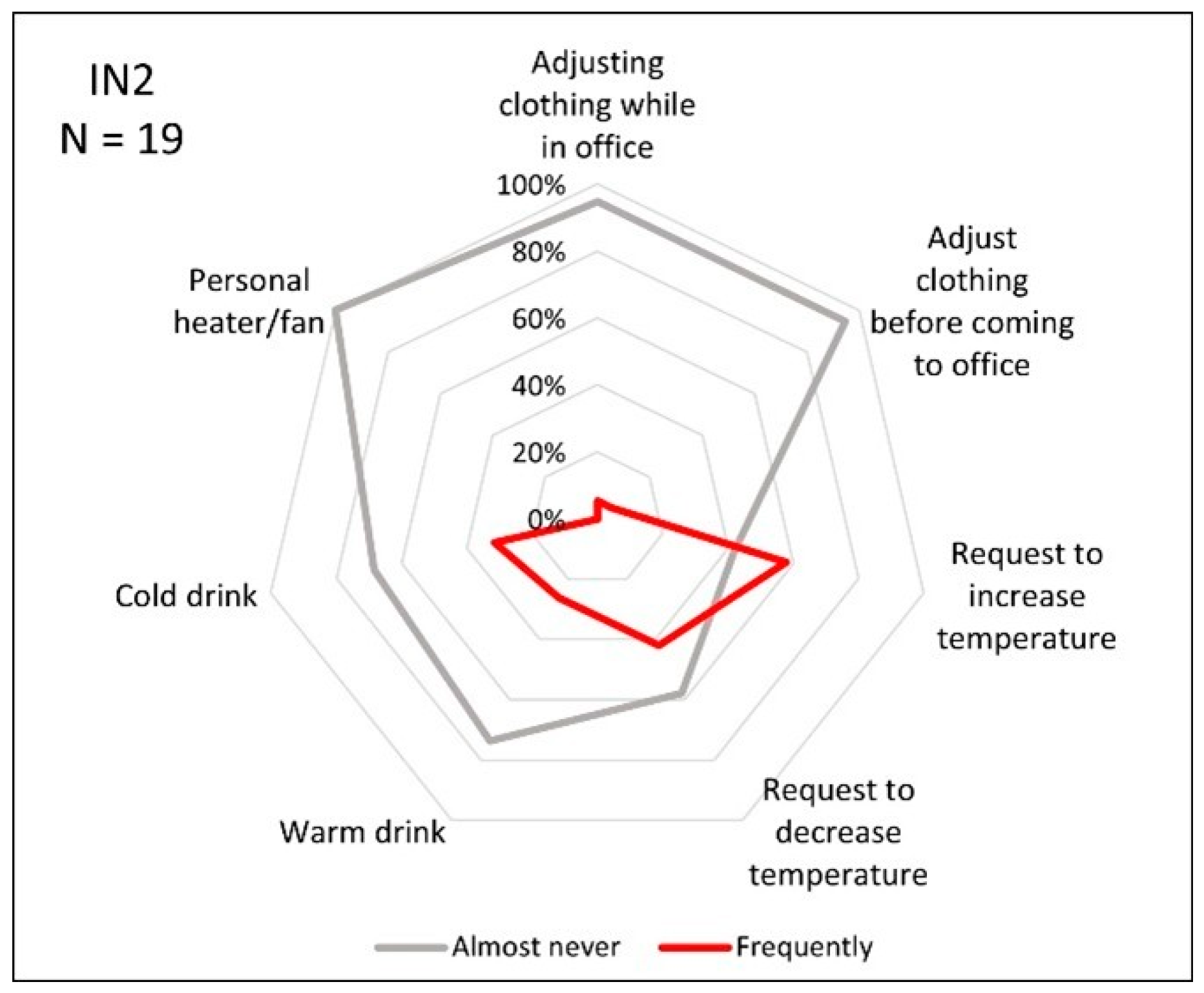
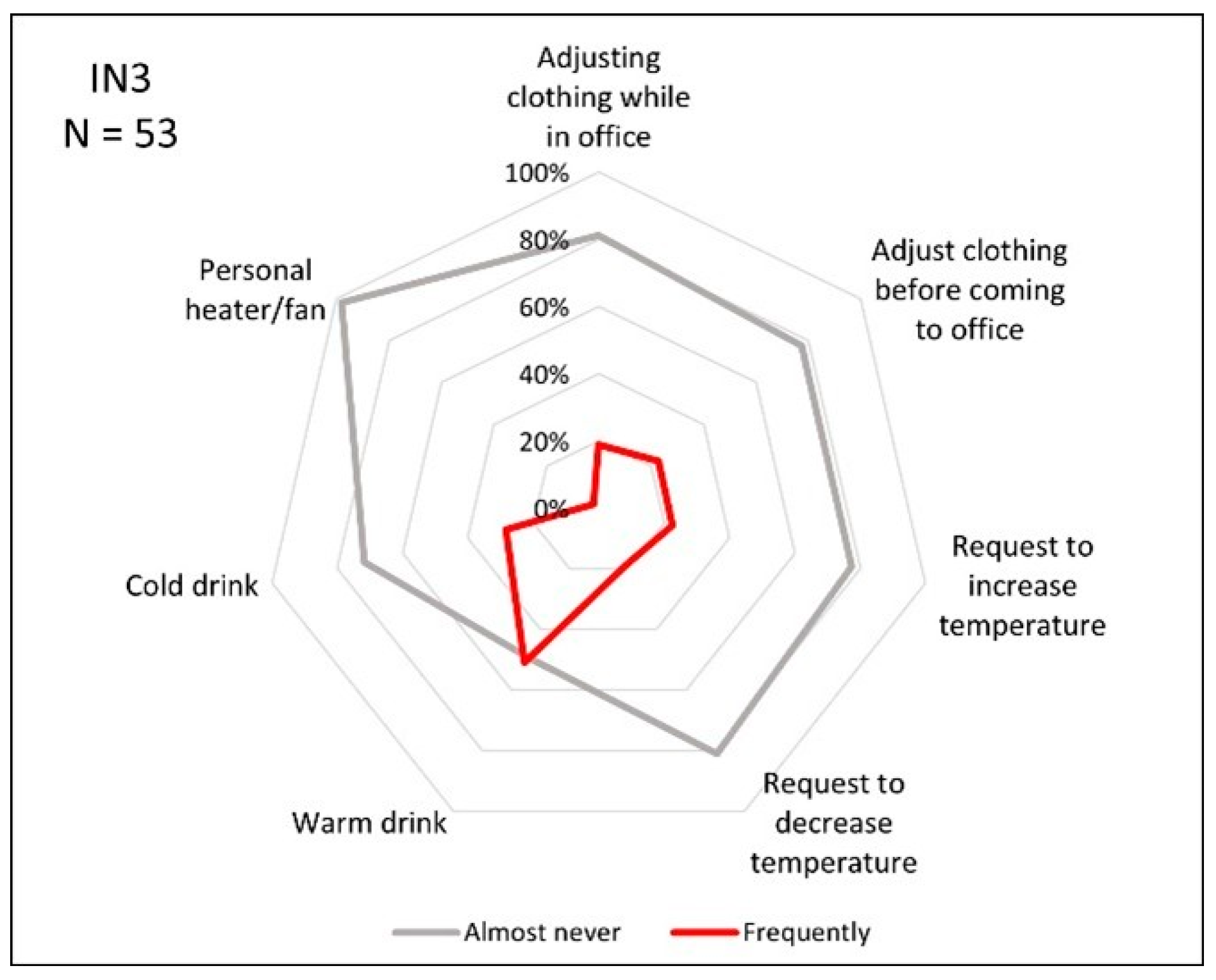
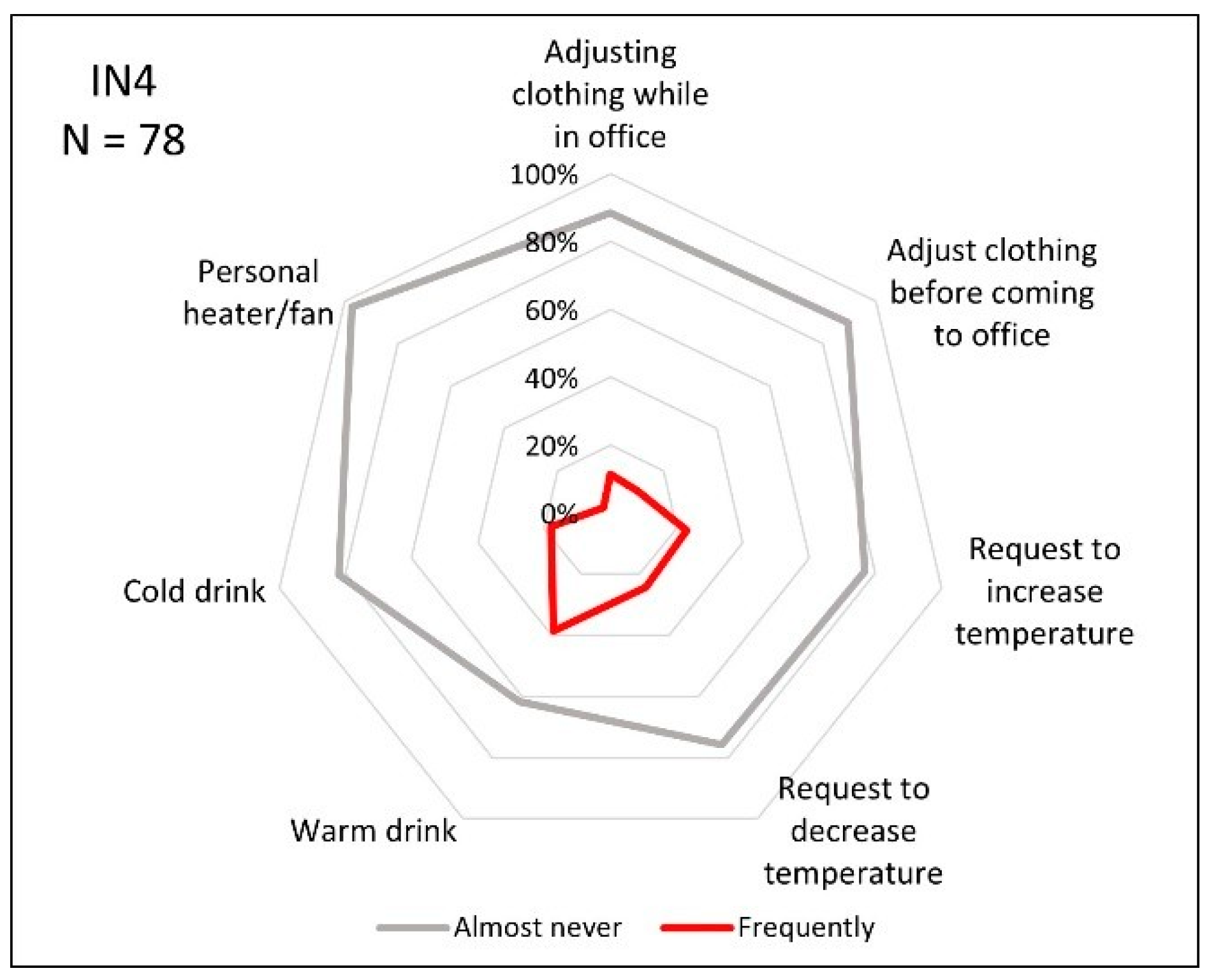


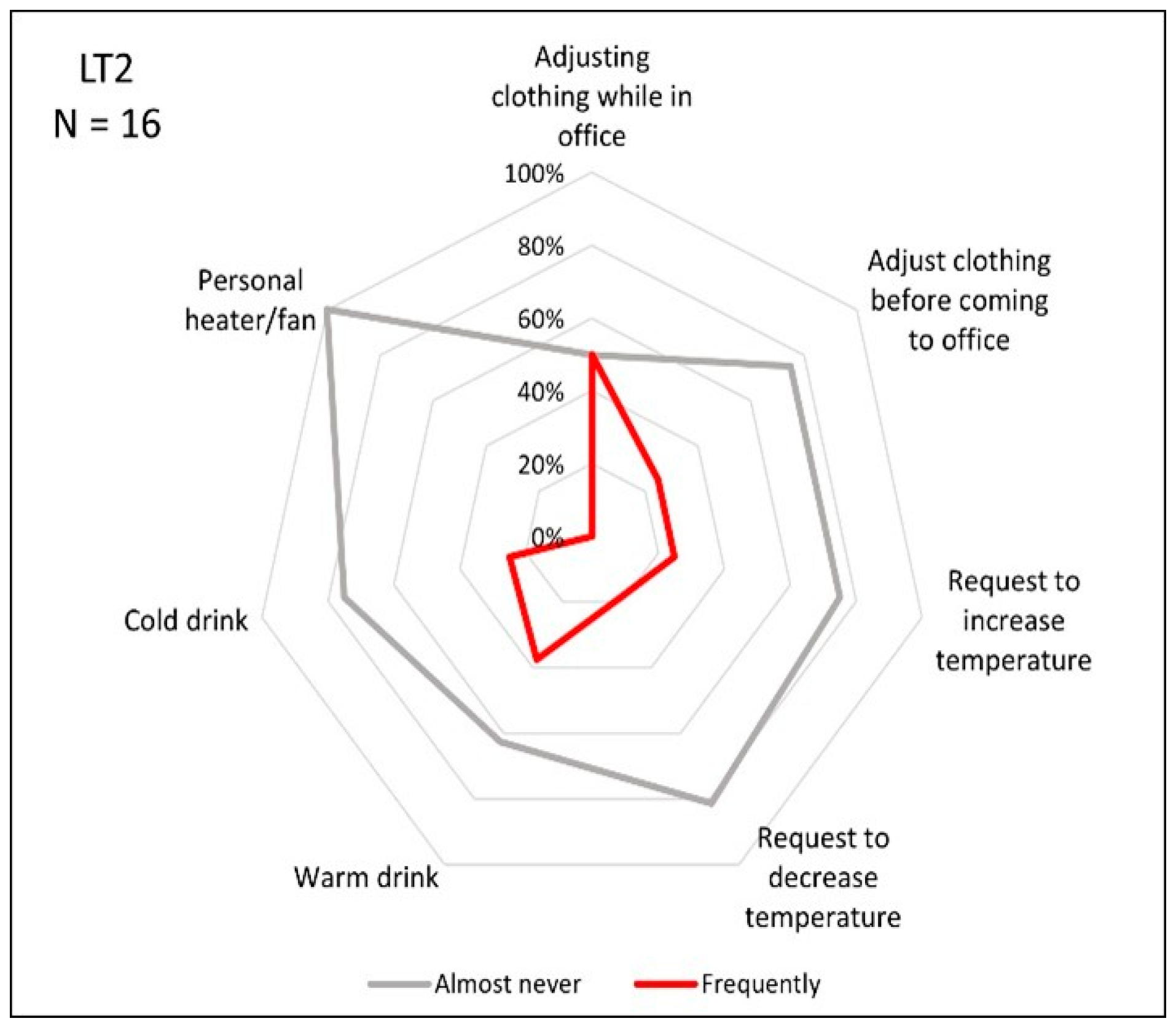
| IN1 | IN2 | IN3 | IN4 | IN5 | LT1 | LT2 | |
|---|---|---|---|---|---|---|---|
| Total number of occupants | 85 | 23 | 98 | 165 | 25 | 128 | 50 |
| Total responses | 62 | 19 | 53 | 78 | 20 | 26 | 16 |
| Response rate (%) | 72.9 | 82.6 | 54.1 | 47.3 | 80 | 20.3 | 32 |
| Gender (respondents) (Male/Female) | 40/22 | 7/12 | 49/4 | 61/17 | 16/4 | 14/12 | 11/5 |
| Age (years) (mean ± SD) | 28 ± 5.58 | 27 ± 5 | 30 ± 0.07 | 37 ± 8.72 | 30 ± 5.22 | 33 ± 7.0 | 29 ± 4.65 |
| Height (m) (mean ± SD) | 1.7 ± 0.07 | 1.6 ± 0.07 | 1.7 ± 0.07 | 1.68 ± 0.08 | 1.67 ± 0.07 | 1.77 ± 0.09 | 1.78 ± 0.11 |
| Weight (kg) (mean ± SD) | 67.2 ± 12.11 | 59.3 ± 12.43 | 72.2 ± 12.83 | 72.6 ± 13.02 | 77 ± 14.4 | 73.0 ± 12.2 | 77.1 ± 14.6 |
| BMI (kg/m2) (mean ± SD) | 24.3 ± 3.96 | 22.2 ± 4.25 | 24.8 ± 4.25 | 25.4 ± 4.35 | 27.9 ± 5.45 | 20.57 ± 2.8 | 21.6 ± 3.74 |
| Thermal Sensation | Very Cold (−3) | Cold (−2) | Slightly Cool (−1) | Neutral (0) | Slightly Warm (+1) | Hot (+2) | Very Hot (+3) |
|---|---|---|---|---|---|---|---|
| Thermal comfort | Very uncomfortable | Slightly uncomfortable | Slightly comfortable | Very comfortable | |||
| Thermal preference | Much warmer | Warmer | Unchanged | Cooler | Much cooler | ||
| Months | India | Lithuania |
|---|---|---|
| December to February | Winter | Winter |
| March to May | Summer | Spring |
| June to September | Monsoon | Summer |
| October to November | Autumn | Autumn |
| Parameter | Sensor | Range | Accuracy |
|---|---|---|---|
| Temperature | Sensirion SHT21 | −40 °C to 125 °C | ±0.3 °C |
| Relative Humidity | Sensirion SHT21 | 0 to 100% | ±2.0% |
| CO2 | SenseAir S8 | 400 to 2000 ppm | ±30 ppm (±3% of reading) |
| Office | Indoor Air Temperature (°C) Average ± SD | Relative Humidity (%) Average ± SD | Average Outdoor Temperature (°C) for the Week of the Experiment (High) | Average Outdoor Temperature (°C) for the Week of the Experiment (Low) |
|---|---|---|---|---|
| IN1 | 28.6 ± 1.5 | 40.6 ± 2.5 | 38.9 | 26.9 |
| IN2 | 28.8 ± 0.6 | 42.5 ± 2.9 | 39.4 | 26.0 |
| IN3 | 25.6 ± 0.9 | 55.8 ± 4.0 | 31.9 | 23.3 |
| IN4 | 25.3 ± 1.0 | 69.4 ± 6.4 | 28.0 | 21.9 |
| IN5 | 24.9 ± 1.0 | 58.9 ± 4.4 | 29.4 | 22.6 |
| LT1 | 23.1 ± 1.0 | 26.6 ± 2.8 | 12.3 | 2.2 |
| LT2 | 22.4 ± 0.5 | 41.9 ± 2.5 | 14.6 | 2.7 |
| Temperature Control Adjustments | Beverage Consumption | Clothing Adjustments | Other | ||||
|---|---|---|---|---|---|---|---|
| Increase temperature (%) | Decrease temperature (%) | Warm drink (%) | Cold drink (%) | Before coming to office (%) | While in office (%) | Use of personal heater/fan (%) | |
| All Occupants (N = 274) | 36 | 27 | 43 | 34 | 20 | 22 | 6 |
| Occupants (all) choosing at least one of the adaptations in the group | 46 | 55 | 29 | 6 | |||
| IN offices (N=232) | 38 | 28 | 44 | 33 | 18 | 17 | 7 |
| Occupants (IN) choosing at least one of the adaptations in the group | 47 | 55 | 24 | 7 | |||
| LT offices (N = 42) | 26 | 21 | 36 | 41 | 33 | 45 | 2 |
| Occupants (LT) choosing at least one of the adaptations in the group | 38 | 55 | 60 | 2 | |||
| Total (N = 274) | Uncomfortable | Comfortable | |
|---|---|---|---|
| No. and percentage of occupants who did not opt for any kind of adaptations | 81 (29.6%) | 11 (14%) | 70 (86%) |
| No. and percentage of occupants who preferred at least one type of adaptation | 193 (70.4%) | 67 (35%) | 126 (65%) |
| Adaptation | Preference | Total (% of Study Population) | Uncomfortable (% of Total) | Comfortable (% of Total) |
|---|---|---|---|---|
| Adjust clothing while in the office | Frequently | 59 (22%) | 18 (31%) | 41 (69%) |
| Almost never | 215 (78%) | 60 (28%) | 155 (72%) | |
| Adjust clothing before coming to the office | Frequently | 55 (20%) | 16 (29%) | 39 (71%) |
| Almost never | 219 (80%) | 62 (28%) | 157 (72%) | |
| Any clothing adjustment | Frequently | 80 (29%) | 23 (29%) | 57 (71%) |
| Request to increase the temperature | Frequently | 99 (36%) | 45 (45%) | 54 (55%) |
| Almost never | 175 (64%) | 33 (19%) | 142 (81%) | |
| Request to decrease the temperature | Frequently | 73 (27%) | 23 (32%) | 50 (68%) |
| Almost never | 201 (73%) | 55 (27%) | 146 (73%) | |
| Any temperature change | Frequently | 126 (46%) | 52 (41%) | 74 (59%) |
| Have a warm drink | Frequently | 117 (43%) | 39 (33%) | 78 (67%) |
| Almost never | 157 (57%) | 39 (25%) | 118 (75%) | |
| Have a cold drink | Frequently | 93 (34%) | 34 (37%) | 59 (63%) |
| Almost never | 181 (66%) | 44 (24%) | 137 (76%) | |
| Any drink | Frequently | 151 (55%) | 57 (38%) | 94 (62%) |
| Use a personal heater/fan | Frequently | 16 (6%) | 8 (50%) | 8 (50%) |
| Almost never | 258 (94%) | 70 (27%) | 188 (73%) |
| Office | Study Period | AMV Average ± SD | Baseline PMV Average ± SD | APD (%) | Baseline PPD (%) | ASHRAE 55 Compliant |
|---|---|---|---|---|---|---|
| IN1 (N = 62) | 23 May–29 May 2022 | 0.1 ± 1.2 | 1.2 ± 0.4 | 45 | 37 | No |
| IN2 (N = 19) | 31 May–6 June 2022 | −0.4 ± 1.1 | 1.3 ± 0.2 | 21 | 39 | No |
| IN3 (N = 53) | 23 June–29 June 2022 | −0.5 ± 1.1 | 0.6 ± 0.2 | 23 | 13 | No |
| IN4 (N = 78) | 4 July–10 July 2022 | −0.3 ± 0.8 | 0.6 ± 0.3 | 17 | 14 | No |
| IN5 (N = 20) | 21 July–28 July 2022 | −0.9 ± 1.2 | 0.4 ± 0.3 | 35 | 10 | Yes |
| LT1 (N = 26) | 3 April–12 April 2023 | 0.3 ± 1.1 | −0.3 ± 0.2 | 23 | 8 | Yes |
| LT2 (N = 16) | 24 April–30 April 2023 | −0.4 ± 0.9 | −0.4 ± 0.1 | 56 | 9 | Yes |
Disclaimer/Publisher’s Note: The statements, opinions and data contained in all publications are solely those of the individual author(s) and contributor(s) and not of MDPI and/or the editor(s). MDPI and/or the editor(s) disclaim responsibility for any injury to people or property resulting from any ideas, methods, instructions or products referred to in the content. |
© 2025 by the authors. Licensee MDPI, Basel, Switzerland. This article is an open access article distributed under the terms and conditions of the Creative Commons Attribution (CC BY) license (https://creativecommons.org/licenses/by/4.0/).
Share and Cite
Tuniki, H.P.; Jurelionis, A.; Rupp, R.F.; Valančius, R.; Bekö, G. Thermal Comfort and Adaptive Occupant Behaviour in Open Plan Offices in India and Lithuania. Buildings 2025, 15, 766. https://doi.org/10.3390/buildings15050766
Tuniki HP, Jurelionis A, Rupp RF, Valančius R, Bekö G. Thermal Comfort and Adaptive Occupant Behaviour in Open Plan Offices in India and Lithuania. Buildings. 2025; 15(5):766. https://doi.org/10.3390/buildings15050766
Chicago/Turabian StyleTuniki, Himanshu Patel, Andrius Jurelionis, Ricardo Forgiarini Rupp, Rokas Valančius, and Gabriel Bekö. 2025. "Thermal Comfort and Adaptive Occupant Behaviour in Open Plan Offices in India and Lithuania" Buildings 15, no. 5: 766. https://doi.org/10.3390/buildings15050766
APA StyleTuniki, H. P., Jurelionis, A., Rupp, R. F., Valančius, R., & Bekö, G. (2025). Thermal Comfort and Adaptive Occupant Behaviour in Open Plan Offices in India and Lithuania. Buildings, 15(5), 766. https://doi.org/10.3390/buildings15050766







